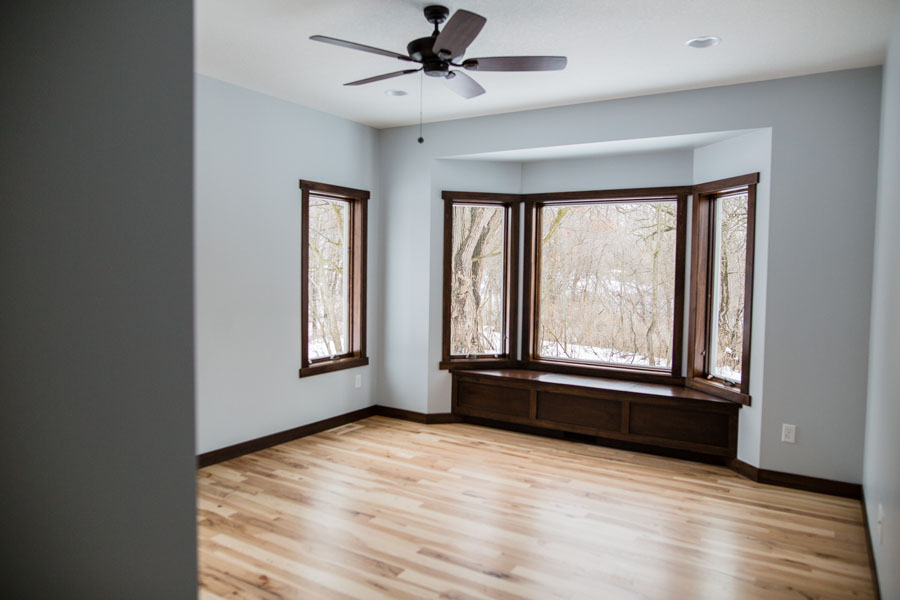 1. Select Solid or Engineered Flooring
1. Select Solid or Engineered Flooring
Today, solid hardwood flooring is still widely available, but many companies also offer engineered flooring – planks that are made with a thinner top layer of hardwood that is bonded to other layers to prevent the flooring from shifting during expansion and contraction cycles. There are three directions that wood moves: tangential, radial, and longitudinal. With engineered products, you’re creating opposing forces within the boards to try to limit the natural movement of the wood.
Concrete subfloors in basements or apartments are more difficult to install than hardwood floors. Engineered flooring can be installed directly over concrete or a soundproofing mat, or over radiant heat, while solid wood flooring is usually installed over one or two layers of plywood.
Be careful when choosing engineered flooring, though. Some of them have top layers that are so thin that they cannot be sanded. The more expensive products typically have a thicker layer where you’re getting more usable wood than you would if you were to buy a solid hardwood board. Keep in mind that solid hardwood only allows you to use the bottom parts for refinishing.
Even though engineered flooring has certain benefits, some homeowners still prefer solid oak flooring. There’s a tangible difference with solid hardwood flooring. It feels soft underfoot and is quieter.
2. Choose Prefinished or Site Finish
Prefinished planks come with a prefinished finish or a raw face which needs to be finished by a professional after installation. One advantage of prefinished wood is that you find out exactly what you’re getting, noting that you’ll have an exact sample to coordinate your home’s color palette and choose other design elements, such as textiles, wall coverings, and cabinetry. In prefinished flooring, no color or sealant is applied, so installation will take less time. In a site finish, you’re taking a gamble that the flooring contractor will do it right.
Many homeowners and designers prefer on-site finishing because it allows fuller control over stain color and sheen. Unfinished flooring is typically sanded after it is nailed down and finished into one continuous plane. The result is a smoother, more uniform final product. It’s a small detail, but it makes a big difference.
3. Choose the Type of Finish
There are a variety of finish products ranging from penetrating oil to polyurethane to prefinished UV-cured urethane finishes. But in order to simplify, most finishes fall into two categories: oil or polyurethane.
However, polyurethane is more durable than oil because it has a hard topcoat on the exterior of the wood that’s less susceptible to wear and tear, especially for homes with children or when food is flying about the kitchen.
With oil finishes, scratches are less noticeable and they can be touched up on a spot-by-spot basis. Conversely, with polyurethane, you’d typically need to replace a board or buff and recoat the entire section.
Maintaining a soft oil finish is easier, but the maintenance is more involved. Polyurethane finishes, by comparison, require minimal maintenance, but the maintenance is more involved.
4. Consider Wood Types
With good reason, oak is the king of hardwood flooring in North America. It’s a very durable wood that takes stain well. It also has an appealing natural grain and is widely available across the region, leading to reasonable prices. White oak is especially popular in design circles because it doesn’t have the pinkish tones of red oak.
A popular choice, walnut is a bit softer than oak, but its deep color makes it perfect for darker rooms. It’s best to start with materials that are naturally toned, enhancing as little as possible to achieve the shades you want. Other readily available North American hardwoods include hickory, cherry, maple, and ash. The choice largely comes down to personal preference when it comes to color and grain.
5. Pick Your Grain Pattern
Logs are cut in three different ways, plain-sawn, rift-sawn, and quarter-sawn, that result in different grain patterns. Plain-sawn wood grain is called cathedral grain and has textured edges.
Quarter-sawn board differ from rift-sawn boards in that they feature added irregular figuring with almost 3D rays that cross the plank. That can be desirable or not, depending on what you are looking for.
Most hardwood flooring is sold as plain-sawn, or as a mix of plain and quarter-sawn wood.
In a more rustic property, we might use plain sawn, while in a more urban environment we might use quarter sawn to add a bit of life.
6. Determine Plank Width
Although a decade ago, most hardwood flooring was installed in two- to three-inch strips, more and more people are using wider planks. There is a feeling of luxury and expense associated with a wider plank. As you exceed the norm, you gain the feeling of luxury. That’s why a four to six-inch plank is our standard specification for every project, however, taking into account that, in general, a bigger room requires a wider plank.
Even though wide plank floors will have fewer seams than thin strips, those seams may eventually become more conspicuous as the wood expands and contracts. Because the movement is not distributed as evenly across more boards, the change may appear exaggerated.


